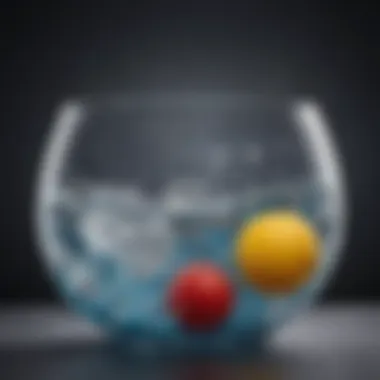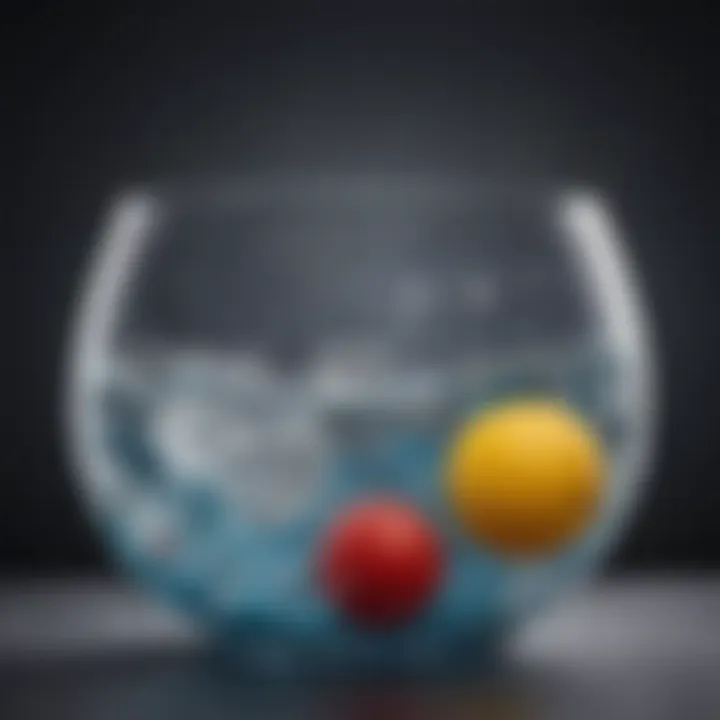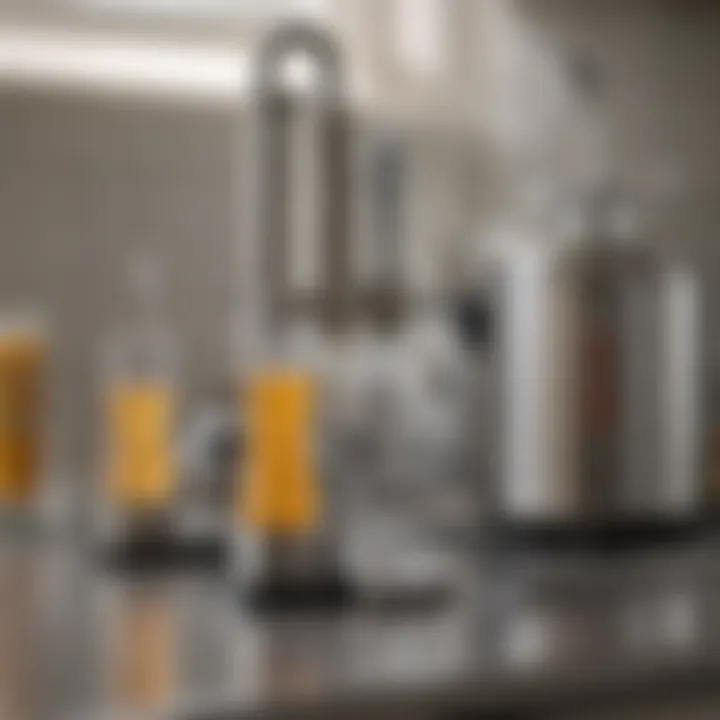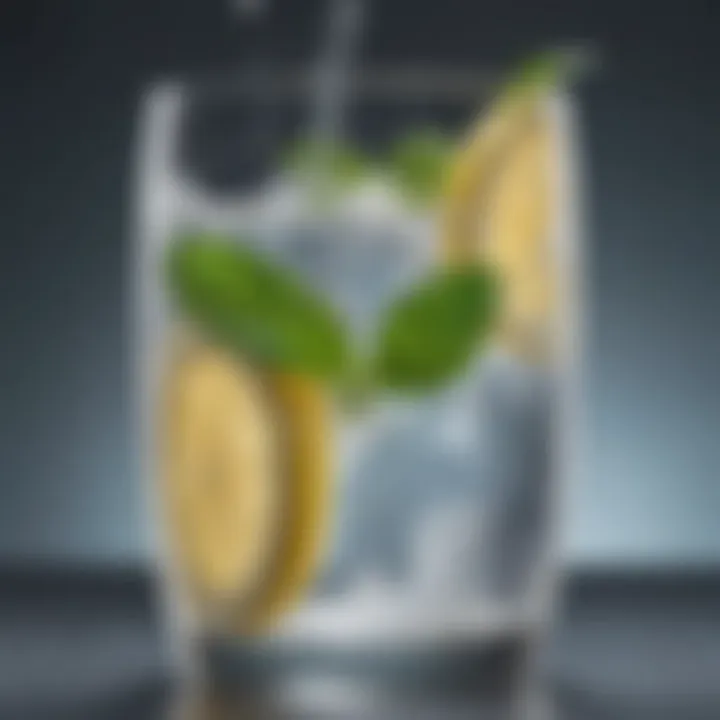Mastering the Art of Homemade Fizzy Water: Techniques and Tools


Intro
The creation of fizzy water, at first glance, might seem like a trivial endeavor. However, the underlying science and methods involved make it a fascinating topic worth exploring. The art of carbonating water has taken root in many homes around the world, particularly among those who wish to enjoy a more tailored beverage experience. It is not merely about bubbles; it encompasses tools, techniques, and an understanding of how carbonation can enchant a mundane drink into something both refreshing and exciting.
Fizzy water is the result of a process where carbon dioxide gas dissolves in water under pressure, resulting in effervescence. The method for achieving this can vary, but the techniques employed are central to ensuring quality and taste achievable in every sip. Whether using specialized machines, simple CO2 cartridges, or less conventional methods, readers will find effective ways to produce fizzy water catering entirely to their preferences.
Moreover, flavoring choices open a further dimension to the craft of carbonation, providing avenues to experiment with creative combinations of ingredients. To truly master fizzy water techniques, it is crucial to examine and understand the many factors involved in obtaining that perfect fizziness and taste.
In this discourse, we will provide a solid grounding in the approaches available for creating fizzy water as well as useful tips for achieving excellent results. Explore the ways to transform your home drinks experience through innovative carbonation methods, tailored flavors, and methodical processes, turning simple water into an enjoyable, sparkling beverage.
Recipe Highlight
- Enticing name: Sparkling Citrus Elixir
- Essential ingredients:
- Estimated preparation time: 10 minutes
- Yield: 4 servings
- Chilled water (750ml)
- Carbon dioxide cartridge (if using a home soda maker)
- Lemon or lime juice (to taste) – ideally fresh
- Optional: sweetener (agave, honey, or sugar)
Step-by-Step Instructions
- Prepare Ingredients: Start by gathering all your ingredients and tools. Ensure your carbonation machine or device is ready.
- Fill Water: Pour chilled water into the carbonation unit, making sure not to exceed the marked limit.
- Carbonation Process: Secure the cap according to your machine's instructions. If using CO2 cartridges, insert it into the device as per the guidance provided.
- Infuse Carbonation: Activate the carbonation mechanism. You can adjust the fizziness according to personal preference – a few short bursts yield lighter carbonation while longer ones lead to richer bubbling.
- Flavor Infusion: In a separate bowl, mix lime or lemon juice according to your taste. You may stir really gently into your carbonated water to infuse flavor.
- Sweetening (optional): If you desire sweetness, add your choice of sweetener and stir very lightly.
- Serve: Pour the fizzy water into glasses and enjoy immediately to capture the fizziness.
Variations and Substitutions
- Alternative ingredients include fruits like berries or cucumber slices for infusing. Herbs like mint can add a refreshing touch.
- If selecting sweeteners, consider stevia or simple syrup instead of granulated sugar.
- Experiment by mixing juices such as grapefruit or orange for different flavor profiles.
Time-Saving Cooking Tips
- To save time, prepare all ingredients in advance to allow for a smoother process.
- Invest in a carbonation machine that is easy to use and clean to maintain efficiency.
- Batch carbonate larger amounts to store in bottles to access ready fizzy drinks throughout the week.
Nutritional Information
- Calories: Approximately 30 calories per serving (depending on sweetener use)
- Key nutrients include vitamin C from the citrus juice and hydration from water themselves.
- The beverage is suitable for various diet offerings, being naturally fat-free, low-sugar, and classically vegan, appealing to diverse dietary preferences.
In an age where carbonated drinks are heavily commercialized, understanding the art behind making your own fizzy water elevates an everyday beverage into a personal experience, providing both enjoyment and creativity.
Preface to Fizzy Water
Fizzy water has gained significant traction in recent years. This popularity stems from not only its effervescent appeal but also the various benefits it offers. The exploration behind creating fizzy water encompasses both scientific and practical aspects. By understanding the processes and each step involved in making it, readers can appreciate the value it adds to their hydration routine.
Definition and Popularity
Fizzy water, often known as sparkling water or carbonated water, is water in which carbon dioxide gas has been dissolved under pressure. This process grants it a bubbly character that separates it from still varieties. Initially preferred in soda and beverages containing sweeteners, fizzy water has transitioned into a standalone choice, reflecting changing consumer preferences leaning towards healthier options.
In this urgent lifestyle where unique drinking experiences are favored, fizzy water serves a dual purpose: it hydrates and entertains. Market growth suggests that many individuals substitute sugary sodas with fizzy water to get both flavor and fizz without the extensive calorie count. Popularity varies globally, with spikes seen during the warmer months as people look for refreshing alternatives.
Health Benefits
The consumption of fizzy water offers several health benefits. First, it can aid digestion. Some studies indicate that carbonated waters may relieve indigestion symptoms and alleviate feelings of fullness. Furthermore, sparkling water can replace sugary drinks, effectively reducing calorie intake.
Another notable benefit is enhanced hydration. The sparkling format entices those who typically avoid plain water. Hydration is crutial for various bodily fuctions; including regulating body temperature and ensuring healthy skin. Sparkling types often enable greater water consumption, supporting daily hydration goals.
Understanding Carbonation
The art of making fizzy water cannot be fathomed without understanding carbonation. This key process is the foundation upon which all sparkling beverages are built. Understanding carbonation goes beyond appreciation of bubbles; it delves into the reasons why some drinks are effervescent while others are not, keeping in mind its importance in achieving the desired taste and texture.
First, knowing what carbonation involves helps to harness the skills for creating consistently enjoyable fizzy water. Moreover, it informs home producers about the suitability of specific tools and ingredients. For both casual creators and serious culinary experimenters, awareness of carbon dioxide's role offers crucial input into crafting light and refreshing drinks. Let's explore carbonation in more detail.
What Is Carbonation?
Carbonation is the dissolution of carbon dioxide gas in a liquid. When CO2 is under pressure and introduced to water, it doesn't merely float away; it interacts with the liquid, creating carbonic acid. This acid contributes both to the distinctive 'bite' that characterizes fizzy beverages and to the preservation of the drink by lowering the pH, making it less hospitable for harmful bacteria.
The phenomenon demonstrates that more than just taste is affected; the mouthfeel and aroma of the beverage shift significantly as well.
Important points include:
- Carbonation contributes to texture or feel of the drink.
- Higher carbonation levels often lead to more pronounced acidity.
- The initial burst upon opening a fizzy beverage is a response to pressure release.


Internally, carbonation can be categorized into two types: natural and forced. Natural carbonation occurs during fermentation, while forced carbonation is achieved manually using machines or CO2 cartridges.
Chemical Process of Carbon Dioxide Dissolution
The chemical process of carbon dioxide dissolution is quite fascinating. In essence, it can be outlined as follows:
- Pressure Activation: A bottle or container is sealed. The additional pressure causes CO2 gas to enter the water.
- Molecular Interactions: As the gas contacts the liquid, molecules of CO2 form bonds with the water molecules.
- Establishing Carbonic Acid: This bond formation results in carbonic acid. The level of carbonic acid impacts not just safety from spoilage, but also flavors and the overall sensory experience of drinking.
- Release of Gas Bubbles: When the container is opened, the pressure falls, allowing carbon dioxide to escape, leading to visible bubbles.
It is beneficial to know that certain parameters can affect the level of carbonation. These include temperature, original pressure, and duration of time the gas is applied. Colder temperatures help hold more CO2 in solution, which is why sparkling water served chilled can seem fizzier than that served at room temperature.
When creating fizzy water, it is critical to recognize the complexity lying behind simple bubbles. Questions of carbonation venture into realms not only of taste but of texture and preservation.
Through understanding carbonation and its chemical subprocesses, enthusiasts can elevate their fizzy water-making skills and ensure consistent results.
Methods to Make Fizzy Water
Making fizzy water at home invokes both science and technique. Understanding the methods available is crucial for producing sparkling beverages of your own. Choosing the right method can greatly influence the quality of fizziness and taste in what you create. Consideration of individual preferences and available tools will enhance your fizzy water experience.
Using a Carbonation Machine
The carbonation machine is a popular option for many due to its convenience and efficiency. This device allows users to make fizzy water easily, offering a user-friendly experience. With just the push of a button, you can transform flat water into a refreshing bubbly beverage.
Benefits of Carbonation Machines
Carbonation machines provide a straightforward solution for achieving fizziness. Key features include the consistent quality of carbonation, customizable levels of fizziness, and user-friendly design. Many users find that carbonation machines are a valuable investment as they eliminate the need for store-bought sparkling water. Additionally, home carbonation reduces plastic waste, aligning with broader sustainability efforts.
One notable benefit of these machines is their simplicity.
Just fill the water bottle with your preferred liquid, attach it to the machine, and start the fizzing process. This ease of use appeals to individuals looking for quick and efficient methods.
Step-by-Step Guide
Understanding how to properly operate a carbonation machine is essential. This step-by-step guide walks you through the process ensuring desirable outcomes.
- Prepare the Water: Begin with cold water. Colder water absorbs CO2 better than warm water.
- Attach the Bottle: Securely attach the designated bottle to the carbonation machine.
- Select the Carbonation Level: Depending on your preference, choose the level of carbonation.
- Press the Button: Activate the machine to start carbonation. Typically, a few short bursts will suffice.
- Unscrew and Enjoy: Carefully unscrew the bottle once complete and enjoy your fizzy water immediately.
It is beneficial to read the specific instructions that come with your carbonation machine, as methods may slightly differ.
Using CO2 Cartridges
Another effective method for producing fizzy water is using CO2 cartridges. These cartridges offer a portable carbonation solution for users who may wish to carbonate beverages away from home.
Types of CO2 Cartridges
When selecting CO2 cartridges, consumers can choose various types based on their carbonation needs. Common types include disposable and refillable cartridges. Disposable cartridges are convenient but may generate more waste. On the other hand, refillable types are often more economical and environmentally friendly.
Each type bears its unique set of advantages and assures effective carbonation. Refillable cartridges typically offer more capacity—to carbonate several liters of water before needing replacement or recharging.
Safety Precautions
While using CO2 cartridges, safety is paramount. Emphasizing precautions can prevent accidents during use. Key safety considerations include handling cartridges carefully, avoiding excessive pressure when attaching them, and using equipment designed exclusively for carbonating liquids. Another pointer is to always store cartridges in a cool environment, as heat can pressure inside the cartridges and lead to mishaps.
It is critical to understanding that improper handling poses risks such as explosions or injuries. Following manufacturer instructions for CO2 cartridges helps ensure safe usage.
DIY Methods Without Specialized Equipment
For those who prefer a hands-on approach, DIY methods come into play. Materials necessary are often found at home, offering an economical route to carbonation.
Alternative Ingredients
Instead of sophisticated gadgets, consider using simple alternative ingredients like baking soda and vinegar for an interesting carbonation experience. The reaction between baking soda (sodium bicarbonate) and vinegar (acetic acid) releases gas that adds fizziness quickly. However, it is essential to manage the amounts to avoid overwhelming bubbles that may lead to spills.
This method brings uniqueness and showcases the practical chemistry behind carbonated beverages, reflecting creativity.
Basic Steps to Follow


Beyond ingredients, successfully creating fizzy water at home mandates following certain simple steps:
- Gather Ingredients: Acquire water, baking soda, and vinegar.
- Mix the Ingredients: In a separate container, combine specific measures of baking soda and vinegar, which results in fizzing.
- Combine with Water: Once the bubbling settles down, pour the mixture into the water bottle, stirring gently for uniform distribution.
- Refrigerate: Chilling the final mix enhances enjoyment and reduces gaseous loss throughout the waiting period.
This approach to fizzy-water-making can be rewarding. Its clear advantages include affordability and accessibility, particularly valuable for those looking for freshness without investment in equipment.
Understanding these various methods creates opportunities for enjoyable experiences with homemade fizzy water. Each technique bears distinct processes and characteristics, while considering tools and personal preferences constructs a pathway toward crafting enjoyable fizzy beverages.
Choosing the Right Water
Choosing the right water for making fizzy water is crucial, yet often overlooked aspect. The quality and type of water can significantly affect the taste and overall experience of your sparkling beverage. It impacts carbonation retention, flavor enhacement, and even the health benefits associated with fizzy water. Here, we delve into two primary types of water: mineral water and distilled water that you can use to create DIY sodas or sparkling water at home.
When determining what water to chose, think about the minerals. Mineral water contains (terms are; calcium, magnesium, sodium) which can impart additional flavors and benefits in your fizzy drink. On the other hand, distilled water lacks these elements, resulting in a more neutral flavor profile. Thus, understanding which water to work with aligns with final taste experiences.
Mineral vs.
Distilled Water
Mineral Water generally contains natural minerals dissolved from its source. This gives fizzy water a unique flavor. Not all mineral water is created equal, however. Some brands add artificial minerals to enhance flavor. When calculating minerals, each type has different profiles. For instance, brands like Topo Chico or San Pellegrino may provide slightly different tastes due to these mineral content variations.
- Pros of Mineral Water:
- Cons of Mineral Water:
- Enhances flavor profile.
- Contains beneficial minerals.
- Many options to select based on flavor preference.
- Can be more expensive.
- Not all options suitable for carbonation.
Distilled Water, conversely, involves boiling water and then allowing it to cool down, recondensing back to fluid. This process removes impurities and minerals leaving you with pure O. It creates a neutral taste which might not be appealing to everyone.
- Pros of Distilled Water:
- Cons of Distilled Water:
- Cost effective option.
- Good for machine carbonators that require purity.
- Lacks flavor due to the absence of minerals.
- Might not provide health benefits found in other types of water.
Ultimately, preference drives which water you decide to use. Experimentation can yield satisfying results. Try combinations of both types. For a stronger flavor enhancement consider sparkling waters enriched with minerals. Conversely, for milder tastes, use distilled water as the base only if your tastes lean that direction.
Temperature Considerations
Temperature plays an important role in successfully creating fizzy water. Cold water has better capacity to dissolve carbon dioxide, creating more bubbles and fizz. Water that is too warm may leads to rapid release and reaction with CO2 causing thinner fizziness. Thus, keeping the water chilled ensures a more successful carbonation process.
Guidance for Temperature:
- Aim for water at 40°F to 60°F.
- If using a carbonation machine, pre-chill the water in the refrigerator.
Most fizzes achieve optimum carbonation Yeah that's usualy happens with a cold beverage because disolved gas in colder drinks significantly stay retained.
Enhancing Flavor in Fizzy Water
Enhancing flavor in fizzy water is essential to create a pleasant drinking experience. Many people may find that plain carbonated water lacks a distinct taste. Adding flavors can elevate the beverage's sensory appeal and provide an attractive alternative to sugary sodas or artificial drinks. Moreover, flavored fizzy water offers hydration benefits while still delivering enjoyable taste options.
Natural Flavorings
Natural flavorings play a crucial role in personalizing fizzy water. They come from sources such as fruits, herbs, spices, and other additives. These flavors can provide various health benefits and are generally perceived as more natural and wholesome compared to artificial options in the market.
Fruits and Herbs
The use of fruits and herbs for flavor enhancement is quite popular. Fresh fruits like lemon, lime, or berries can infuse delightful tastes into fizzy water. The juice or sliced fruit pieces release their distinct flavors when mixed into sparkling water. Thus, one can achieve refreshing combinations effortlessly.
Herbs such as mint or basil add another layer of depth. The ventilation of these herbs releases aromatic properties responsibly, making it a beneficial addition for consumers seeking a unique twist.
However, there are a few drawbacks. Fresh fruits can spoil quickly. They require immediate consumption after preparation. Herbs may turn bitter if used excessively. Still, the unique abilities of fruits and herbs make them a popular choice for enhancing bubbly drinks.
Spices and Other Additives
Spices and other additives also present intriguing options for flavor enhancement. Ginger, for instance, provides a spicy kick and is well-known for its digestive aid properties. Typically, ginger can be grated and mixed with fizzy water to get this flavor profile.


Potential Challenges and Solutions
Creating fizzy water at home is exciting, yet it can also present challenges. Understanding common issues helps in developing effective solutions. This section will provide an overview of some frequent challenges users face, such as insufficient fizz and over-carbonation. By resolving these, readers can enjoy a consistently bubbly beverage. Not only does mastering these potential hurdles enhance the quality of homemade fizzy water, but it also deepens knowledge of carbonation techniques.
Insufficient Fizz
Insufficient fizz in your homemade sparkling water can be frustrating. Numerous factors can contribute to this issue.
Identifying the Causes
Identifying the causes of insufficient fizz is paramount for achieving optimal carbonation levels. The carbonation process itself plays a role, as improper techniques can lead to low gas retention. Several characteristics can hinder carbonation. These include water temperature, exposure to oxygen, and the rate of CO2 dissolving into the water. Importantly, temperature affects how well CO2 can be absorbed by the liquid. As the temperature rises, CO2's ability to remain dissolved decreases. Hence, cooler water yields a better effervescent outcome. Understanding these variables empowers users to actively control the fizziness in their beverages.
Adjusting Techniques
Adjustment techniques are vital in optimizing the carbonation process. By making some small changes, one can significantly improve fizz. For instance, carbonating water at a lower temperature enhances gas solubility. In addition, increasing hold time for cartridges improves carbonation density; allowing gas to remain in contact with water longer gives a better penetration effect. This technique strategically exploits water properties for increased fizz, hence providing robust results. Users should remember that incorporating simple adjustments can directly influence the final product.
Over-carbonation Issues
Over-carbonation comes with its own challenges. Users might find that excessive carbonation creates a dessert experience rather than a refreshing drink. The clearer understanding of balance between freshness and fizz is needed. Controls on CO2 input and waters limits contribute greatly to a well-rounded homemade fizzy water experience.
To deal with over-carbonation challenges:
- Monitor Time: Track the duration during which the carbonation occurs. A longer carbonation sometimes leads to overfizz.
- Decrease CO2 Input: Reducing the pressure of CO2 input helps avoid buoyant bubbles emerging in a turbulent way.
- Temperature Checks: Using warmer water can surprisingly lower fizzy density, thus reducing risks of excessive carbon quite efficiently.
By identifying these potential challenges and adjusting your techniques accordingly, you lay the foundation for mastering the art of fizzy water production. Shifting variables, such as temperature, technique, and carbonation length allows for dynamic enhancement and ultimately culminates in a satisfying beverage experience.
Sustainability Considerations
Sustainability is crucial when discussing the production of fizzy water at home. As more individuals recognize the environmental impact of their choices, understanding how to balance consumption with ecological responsibility becomes essential. Various factors play a role in framing sustainability within the context of carbonation, from the materials used in carbonation equipment to the disposal of packaging.
One major area of concern is the environmental footprint of carbonation machines. While these devices allow users to create fizzy water at home, their manufacturing, energy use, and waste materials can contribute to environmental degradation. By making informed choices about the equipment used, one can mitigate these negative effects. Opting for energy-efficient machines reduces electricity consumption, which is beneficial for the planet. The extent of carbon emissions released during production and distribution also warrants consideration. Selecting high-quality, durable products means less frequent replacements, which is an effective strategy in minimizing waste.
A further aspect to contemplate is the transportation associated with purchasing commercially bottled sparkling water. This process often generates significant carbon emissions since bulky liquids are typically transported over long distances. By creating fizzy water at home, individuals can significantly reduce their carbon footprint.
Environmental Impact of Carbonation Equipment
Carbonation equipment, like machines and kits, carry varying environmental implications. Manufacturing processes can consume resources and generate pollution. To analyze these devices' sustainability, their overall lifecycle must be considered, including production, energy use during operation, and eventual disposal. Some carbonation machines have a longer lifespan and fewer challenges in recycling. This feature contributes to better long-term sustainability.
Unavoidably, materials such as plastics are used in many carbonation devices. The fate of these materials after they are no longer needed poses an immportant challenge. Proper recycling systems need to be in place, and consumers must be aware of how to minimize waste.
In addition to the equipment itself, the effort required to maintain fizzy water production equipment should not go unmentioned. If a consumer chooses poorly designed devices requiring extra resources for maintenance and repairs, their environmental impact increases. Therefore, selecting a device that sticks to the basic principles of sustainability is crucial.
"A consumer's choice of carbonation equipment directly impacts future efforts toward sustainability."
Reusable Packaging Solutions
Reusable packaging is an effective way of reducing waste related to fizzy water. Often, consumables come in single-use bottles or cans, which become problematic regarding environmental sustainability. Considering modifications to typical consumption habits can lead one to better habits. Consumers can invest in bottles designed specifically for carbonation, which allows them to make and store their fizzy drinks multiple times. Putting efforts into reusable containers is not just about utility, but also a serious commitment to environmental preservation.
Moreover, many carbonation systems offer various refillable CO2 cartridges. Utilizing these options assigns value back to the original product, as they can be replenished through services that promote sustainability. Manufacturers often create systems backed by collection and recycling programs for empty cartridges, turning a potential waste item into a valuable resource.
As food lovers or everyday consumers implement these sustainable practices, they also inspire those around them. The ripple effect can contribute to greener communities, with informed consumers choosing wisely to reflect the growing importance of sustainability. By adopting reusable solutions and being mindful of product life cycles, individuals can enjoy fizzy water while also caring for the planet.
End and Final Thoughts
Creating fizzy water at home is more than just a fun experimentation in the kitchen; it embodies a unique blend of science and personal preference. Understanding the fundamental principles of carbonation can transform not only the way sparkling beverages are made but also enhance the drinking experience. This article has served as a guide detailing various methods, tools, and considerations required to craft fizzy water tailored to individual tastes.
Before delving deeper into unique creations, it is essential to reflect on the aspects outlined throughout the article. The insights into the different carbonation techniques like using a carbonation machine, CO2 cartridges, and even simple DIY methods have illustrated that anyone, regardless of their culinary skill level, can produce effective results.
Another significant consideration has been the choice of water, flavors, and sustainability factors. As the world leans more towards environmentally conscious choices, making fizzy water at home reduces the reliance on bottled sparkling drinks and encourages a more resourceful lifestyle. Home carbonation also opens avenues for natural flavor enhancements, empowering individuals to personalize their beverages without sending unnecessary plastic waste into landfills.
Ultimately, the art of fizzy water production encourages exploration not just within the confines of recipes but also into the chemistry involved, stripping the process down to its essentials.
Recap of Key Points
- Methodological Insight: We have discussed various methods to create fizzy water, particularly emphasizing the use of carbonation machines and CO2 cartridges.
- Flavor Enrichment: Understanding the role of natural flavorings and commercial options aids in personalizing the drink to suit different palates.
- Sustainability: The shift towards home carbonation reflects broader societal trends towards minimizing environmental impact through reusable packaging and reducing waste.
- Creative Exploration: Each method presented offers space for creativity, allowing freedom to tweak ingredients and steps for a preferred outcome.
Encouragement to Experiment
With a solid grounding in the science and techniques of making fizzy water, it is time to embrace ingenuity. Each method lays the groundwork for variation. Using seasonal fruits like strawberries or herbs such as mint can invigorate both the palate and the imaginative process.
Perhaps one can explore garnishing fizzy water with citrus slices or even integrating exotic spices for warmth. Over time, small adjustments lead to discovering a signature ‘fizz’ that resonates with one’s taste.
There is no single right way to create fizzy water, allowing for endless experimentation. By harnessing those varying methods and materials, one channels not only the art of beverage crafting but also engages with a friendly, sustainable practice. Enjoy the process and share the outcomes with peers. Each effort manifests the alchemy of science in the kitchen, ultimately making drinking sparkling water a delightful and personalized experience.







